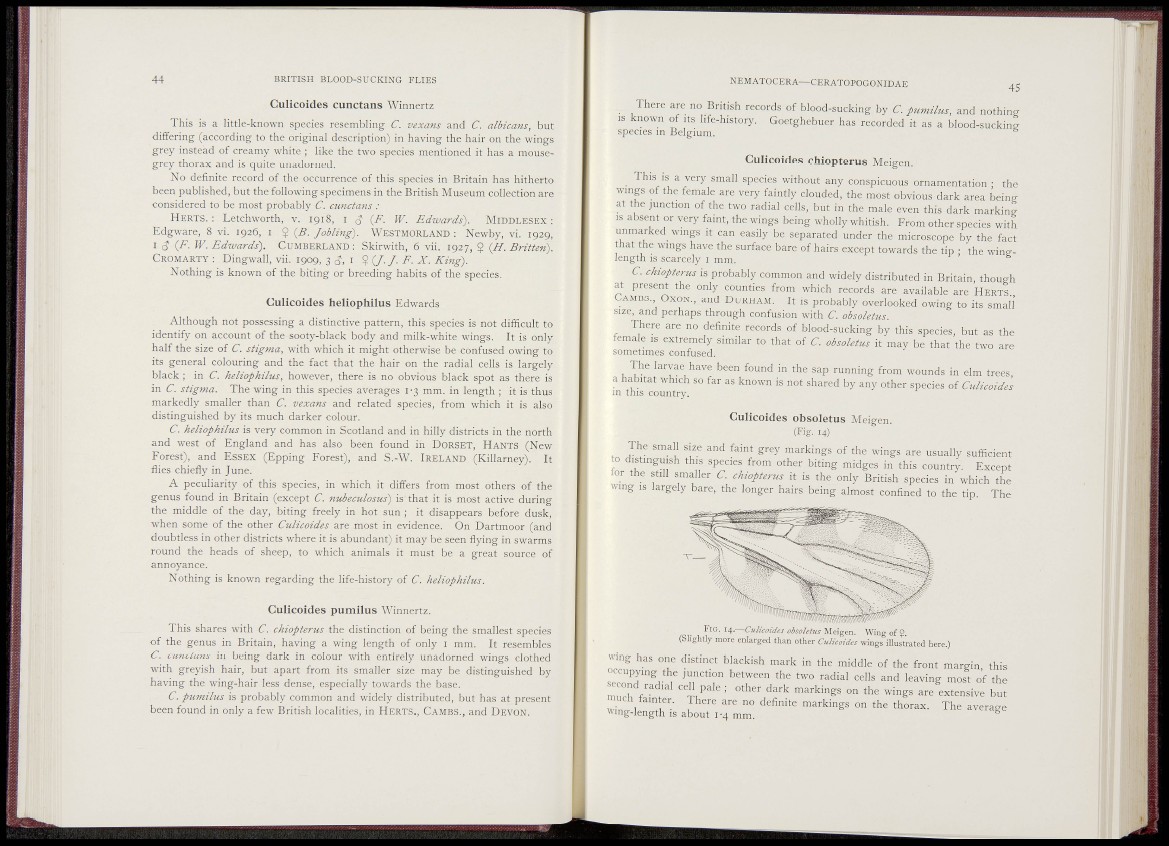
44 B R I T I S H BLOOD-SUCKING FLIES
Culicoides cunctans Winnertz
This is a little-known species resembling C. vexans and C. albicans, but
differing (according to tiie original description) in having the hair on the wings
grey instead of creamy white ; like the two species mentioned it has a mousegrey
thorax and is quite unadorned.
No definite record of the occurrence of this species in Britain has hitherto
been published, but the following specimens in the British Museum collection are
considered to be most probably C. cunctans :
HERTS.: Letchworth, v. 1918, i ^ (F. W. Edwards). MIDDLESEX:
Edgware, 8 vi. 1926, i $ {B. Jobling). WESTMORLAND : Newby, vi. 1929,
I (F. W.Edwards). CUMBERLAND: Skirwith, 6 vii. 1927, $ (H. Britten).
CROMARTY : Dingwall, vii. 1909, 3 CI, i ? (/•/• F. X. King).
Nothing is known of the biting or breeding habits of the species.
Culicoides heliophilus Edwards
Although not possessing a distinctive pattern, this species is not difficult to
identify on account of the sooty-black body and milk-white wings. It is only
half the size of C. stigma, with which it might otherwise be confused owing to
its general colouring and the fact that the hair on the radial cells is largely
black ; in C. heliophilus, however, there is no obvious black spot as there is
in C. stigma. The wing in this species averages 1-3 mm. in length ; it is thus
markedly smaller than C. vexans and related species, from which it is also
distinguished by its much darker colour.
C. heliophilus is very common in Scotland and in hilly districts in the north
and west of England and has also been found in DORSET, HANTS (New
Forest), and ESSEX (Epping Forest), and S.-W. IRELAND (Killarney). It
flies chiefly in June.
A peculiarity of this species, in which it differs from most others of the
genus found in Britain (except C. nubeculosus) is that it is most active during
the middle of the day, biting freely in hot sun ; it disappears before dusk,
when some of the other Culicoides are most in evidence. On Dartmoor (and
doubtless in other districts where it is abundant) it may be seen flying in swarms
round the heads of sheep, to which animals it must be a great source of
annoyance.
Nothing is known regarding the life-history of C. heliophilus.
Culicoides pumilus Winnertz.
This shares with C. chiopterus the distinction of being the smallest species
of the genus in Britain, having a wing length of only i mm. It resembles
C. cunctans in being dark in colour with entirely unadorned wings clothed
with greyish hair, but apart from its smaller size may be distinguished by
having the wing-hair less dense, especially towards the base.
C. pumilus is probably common and widely distributed, but has at present
been found in only a few British localities, in HERTS., CAMBS., and DEVON.
NEMATOCERA^CERATOPOGONIDAE 45
^ There are no British records of blood-sucking by C. pumilus, and nothing
IS known of its life-history. Goetghebuer has recorded it as a blood-suckincr
species m Belgium.
Culicoides chiopterus Meigen.
This is a very small species without any conspicuous ornamentation • the
wmp of the female are very faintly clouded, the most obvious dark area being
at the junction of the two radial cells, but in the male even this dark marking
IS absent or very faint, the wings being wholly whitish. From other species with
unmarked wings it can easily be separated under the microscope by the fact
that the wings have the surface bare of hairs except towards the tip ; the winelength
IS scarcely i mm.
C. chiopterus is probably common and widely distributed in Britain, though
at present the only counties from which records are available are HERTS
CAMBS. OXON., and DURHAM. It is probably overiooked owing to its small
size, and perhaps through confusion with C. obsoletus.
There are no definite records of blood-sucking by this species, but as the
female is extremely similar to that of C. obsoletus it may be that the two are
sometimes confused.
The larvae have been found in the sap running from wounds in elm trees
a habitat which so far as known is not shared by any other species of CuHcoides
m this country.
Culicoides obsoletus Meigen.
( F i g . 14)
The small size and faint grey markings of the wings are usually sufficient
to distinguish this species from other biting midges in this country. Except
ior the still smaller C. chtopterus it is the only British species in which the
wing IS largely bare, the longer hairs being almost confined to the tip The
FIG. 14.—Culicoides obsoletus Meigen. Wino- of $
(Slightly more enlarged than other Culicoides wings'illustrated here.)
Wing has one distinct blackish mark in the middle of the front margin this
occupying the junction between the two radial cells and leaving most of the
second radial ce^ pale ; other dark markings on the wings are extensive but
much fainter. There are no definite markings on the thorax. The average
wing-length is about 1-4 mm. ^
^MiéMém-É